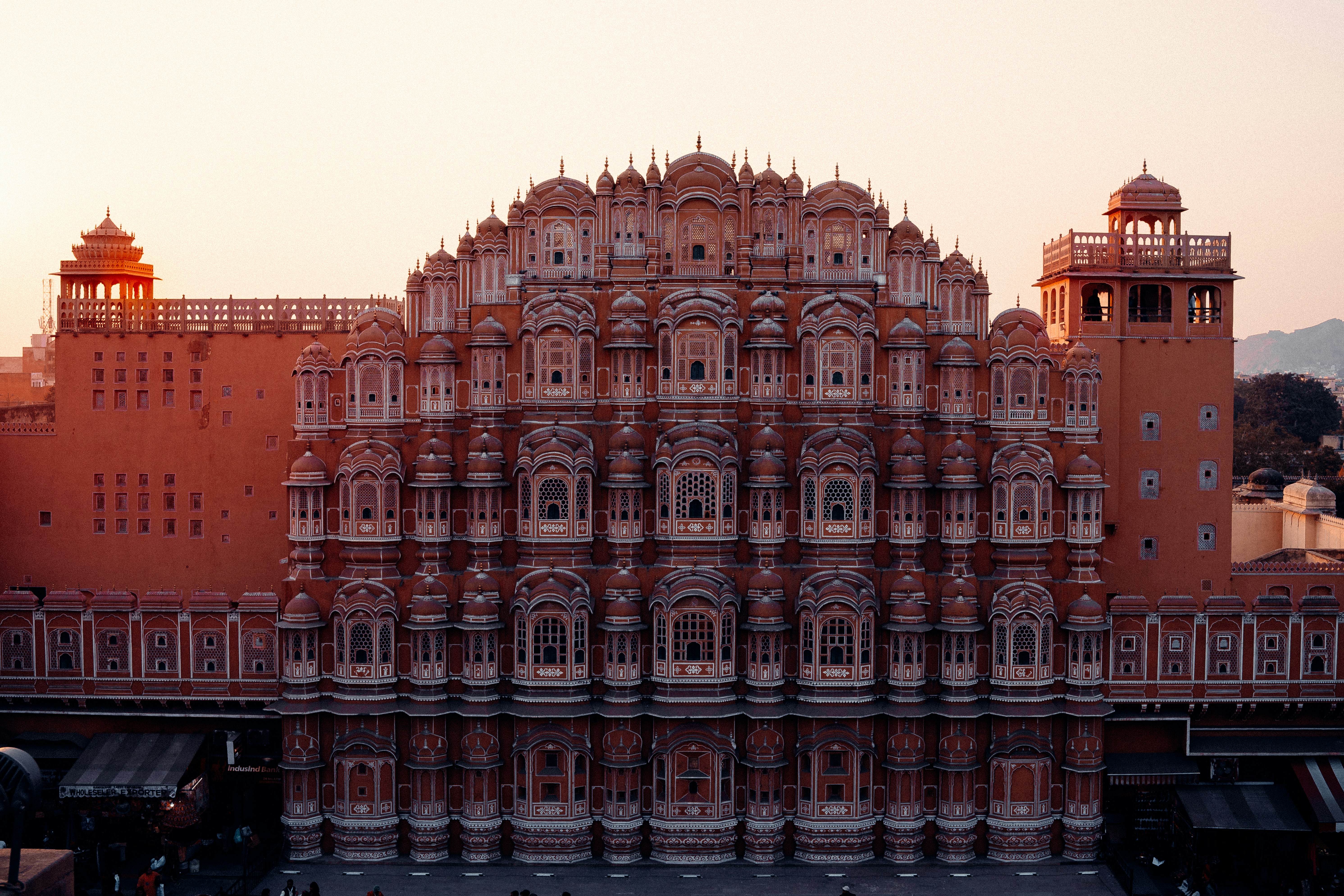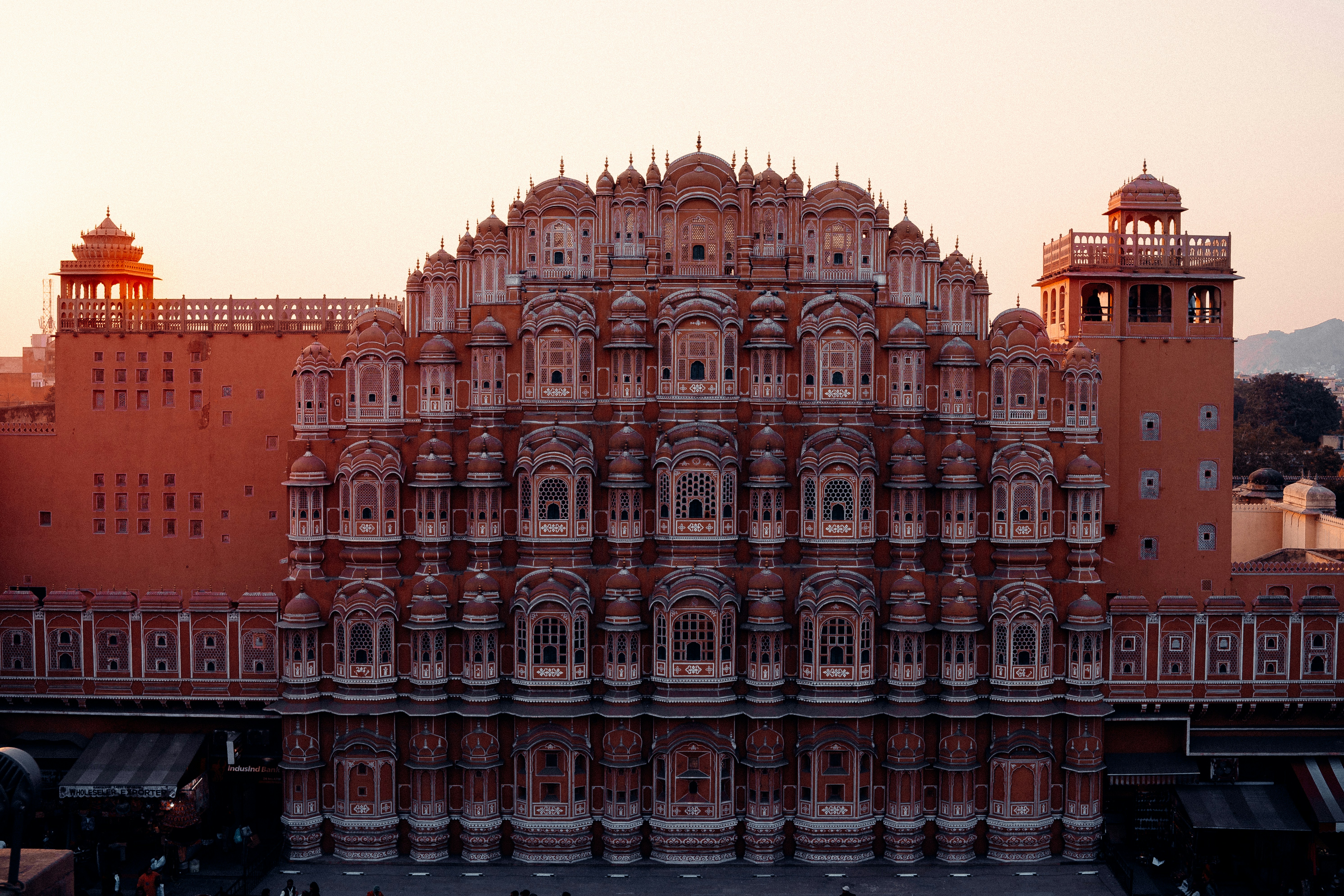As you step into the vibrant streets of Jaipur, you are immediately transported to a world of opulence and grandeur. The city’s nickname, the Pink City, is derived from the blush-colored sandstone that adorns its buildings. This unique hue gives Jaipur a romantic and ethereal charm, making it a photographer’s dream.
One of the city’s most iconic landmarks is the magnificent Hawa Mahal, also known as the Palace of Winds. This architectural marvel features intricate latticework and 953 small windows, allowing the royal ladies to observe the bustling street below without being seen. As you stand in awe of its grand facade, you can’t help but imagine the whispers of the past and the secrets it holds.
Jaipur is also home to the majestic City Palace, a sprawling complex that showcases the perfect blend of Rajput and Mughal architecture. As you wander through its ornate courtyards, you’ll be captivated by the exquisite craftsmanship and the stunning art pieces on display. Don’t miss the chance to visit the museum within the palace, which houses a remarkable collection of artifacts, including royal costumes, weapons, and ancient manuscripts.
No visit to Jaipur would be complete without exploring the vibrant bazaars that line its streets. From the famous Johari Bazaar, known for its exquisite jewelry and gemstones, to the bustling Bapu Bazaar, where you can find colorful textiles and handicrafts, these markets offer a sensory overload of sights, sounds, and smells. Immerse yourself in the chaos and haggle with the friendly shopkeepers to score unique souvenirs to take back home.
For those seeking a spiritual experience, Jaipur is dotted with magnificent temples that showcase the city’s religious diversity. The Birla Mandir, made entirely of white marble, is a serene oasis where you can seek solace and admire the intricate carvings that adorn its walls. The Govind Dev Ji Temple, dedicated to Lord Krishna, is another must-visit, especially during the evening aarti (prayer ceremony) when the temple comes alive with devotional chants and the fragrance of incense.
As the sun sets over Jaipur, the city transforms into a magical wonderland. The Nahargarh Fort, perched on a hilltop, offers breathtaking panoramic views of the city bathed in golden hues. Take a leisurely stroll along the fort’s ramparts and soak in the mesmerizing beauty that surrounds you. For a truly unforgettable experience, dine at one of the rooftop restaurants that offer a stunning view of the illuminated city below.
Jaipur is not just a city; it is a sensory journey that will leave you spellbound. From its regal palaces to its bustling markets, from its spiritual temples to its breathtaking views, this Pink City paradise is a destination that will captivate your heart and ignite your imagination. So, pack your bags and embark on a journey of a lifetime to Jaipur, where history, culture, and beauty converge.
Jaipur, the capital city of the Indian state of Rajasthan, is a vibrant and culturally rich destination that offers a glimpse into the region’s captivating history. Founded in 1727 by Maharaja Sawai Jai Singh II, Jaipur was meticulously planned and designed as a symbol of prosperity and architectural brilliance.
The city’s unique architectural layout is a testament to the vision and foresight of its founder. The streets are laid out in a grid-like pattern, with wide roads and well-organized blocks. This planning was not only aesthetically pleasing but also served practical purposes such as efficient transportation and defense.
One of the most iconic features of Jaipur is its pink buildings, which earned it the nickname “Pink City.” The story behind this distinctive color dates back to 1876, when the Prince of Wales visited Jaipur. In order to welcome him, the city was painted pink, as it symbolizes hospitality in Rajasthani culture. Since then, the pink hue has become synonymous with Jaipur’s identity.
Jaipur’s history is deeply rooted in the Rajputana dynasty and the Mughal Empire, both of which have left an indelible mark on the city’s architecture and culture. As you wander through the streets of Jaipur, you’ll encounter magnificent forts, palaces, and havelis that stand as a testament to the grandeur of these eras.
The Amber Fort, located on a hilltop overlooking the city, is a prime example of Rajputana architecture. Its impressive walls and intricate carvings showcase the opulence and artistic prowess of the Rajput rulers. Inside the fort, you can explore the Diwan-i-Aam (Hall of Public Audience), the Sheesh Mahal (Mirror Palace), and the Ganesh Pol (Gate of Ganesh), each offering a glimpse into the rich history and cultural heritage of Jaipur.
Nahargarh Fort, another prominent landmark in Jaipur, was built as a defensive structure on the Aravalli hills. From its vantage point, you can enjoy panoramic views of the cityscape and the surrounding landscape. The fort’s imposing architecture and strategic location make it a must-visit destination for history enthusiasts.
The City Palace, located in the heart of Jaipur, is a magnificent complex that showcases a blend of Rajput and Mughal architectural styles. This sprawling palace complex houses several palaces, courtyards, gardens, and museums, all of which provide a fascinating insight into the lives of the royals who once resided here.
As you delve deeper into Jaipur’s history, you’ll uncover countless stories of valor, romance, and cultural heritage. The city’s rich tapestry of history and architecture is a testament to the legacy of its past rulers and the enduring spirit of its people.
One of the lesser-known architectural marvels in Jaipur is the Jantar Mantar, an astronomical observatory built by Maharaja Jai Singh II in the early 18th century. This UNESCO World Heritage Site is a collection of 19 architectural instruments that were used to measure time, track celestial bodies, and predict astronomical events. The precision and accuracy of these instruments, even by today’s standards, are truly remarkable.
For those with a penchant for palaces, the City Palace is a must-visit. This sprawling complex is a beautiful blend of Rajput and Mughal architecture and is still home to the royal family of Jaipur. As you explore its courtyards, museums, and galleries, you’ll get a glimpse into the rich history and culture of the city.
If you’re interested in religious architecture, the Birla Mandir is a sight to behold. This white marble temple dedicated to Lord Vishnu and Goddess Lakshmi is a perfect example of modern Indian temple architecture. The intricate carvings, delicate sculptures, and stunning stained glass windows make it a visual delight.
Jaipur is also home to several magnificent step wells, known as baoris. These architectural wonders were not only used as a source of water but also as gathering places and cooling spots during the scorching summers. The Panna Meena Ka Kund and the Chand Baori are two of the most famous step wells in Jaipur, known for their intricate geometric patterns and architectural brilliance.
As you wander through the streets of Jaipur, you’ll also come across numerous havelis, or traditional mansions. These ornate buildings with their intricately carved facades and colorful frescoes are a testament to the city’s rich architectural heritage. Some of the notable havelis include the Samode Haveli, the Narain Niwas Palace, and the Seth Ram Das Ji Ka Mandir.
Whether you’re an architecture enthusiast or simply appreciate the beauty of well-crafted buildings, Jaipur is a paradise that will leave you in awe. From palaces and forts to temples and step wells, the city’s architectural marvels are a testament to the rich history, culture, and craftsmanship of Rajasthan.
Exploring the Rich History
Aside from its cultural offerings, Jaipur is also a city steeped in history. As the capital of Rajasthan, it is home to numerous historical sites that are a testament to its glorious past. One such site is the majestic Amer Fort, a UNESCO World Heritage Site that dates back to the 16th century.
The Amer Fort is a marvel of Rajput architecture, with its intricate carvings, stunning mirror work, and beautiful frescoes. Exploring the fort’s sprawling complex, you can visit the Diwan-i-Aam (Hall of Public Audience), the Diwan-i-Khas (Hall of Private Audience), and the Sheesh Mahal (Palace of Mirrors).
Another must-visit historical site in Jaipur is the City Palace, which was once the seat of the Maharaja of Jaipur. This sprawling palace complex is a blend of Rajput, Mughal, and European architectural styles. Inside the palace, you can explore the various courtyards, gardens, and museums that showcase the rich history and heritage of the city.
For those interested in astronomy, a visit to the Jantar Mantar is a must. This UNESCO World Heritage Site is an astronomical observatory built in the 18th century by Maharaja Jai Singh II. It houses a collection of architectural instruments that were used to measure time, track celestial bodies, and predict eclipses.
As you wander through Jaipur’s historical sites, you can’t help but be transported back in time, imagining the grandeur and opulence of the Rajput rulers who once called this city their home.
If you’re looking to escape the hustle and bustle of the city, a visit to the serene and picturesque town of Pushkar is highly recommended. Just a short drive away from Jaipur, Pushkar is famous for its annual camel fair and the sacred Pushkar Lake. This holy city attracts spiritual seekers from all over the world who come to take a dip in the holy waters of the lake and seek blessings at the Brahma Temple, the only temple dedicated to Lord Brahma in the world.
For wildlife enthusiasts, Ranthambore National Park is a must-visit. Located about 130 kilometers from Jaipur, this national park is home to the majestic Royal Bengal Tigers. Embark on a thrilling safari and witness these magnificent creatures in their natural habitat. The park is also home to a variety of other wildlife, including leopards, sloth bears, and over 300 species of birds. It is a paradise for nature lovers and photographers alike.
If history is your passion, a visit to the UNESCO World Heritage site of Jantar Mantar is a must. Built by Maharaja Jai Singh II, this astronomical observatory features a collection of architectural instruments used to study celestial bodies. The site is a testament to India’s scientific and technological advancements during the 18th century. Marvel at the precision and accuracy of these ancient instruments and gain a deeper understanding of India’s rich astronomical heritage.
These are just a few examples of the many attractions and experiences that await you in and around Jaipur. Whether you’re seeking spiritual enlightenment, wildlife encounters, or a journey through history, Jaipur and its surroundings have something for everyone. So pack your bags, embark on an adventure, and discover the wonders that await you in the Pink City and beyond.
Enter your email to get the Latest Updated Exploring News and Topics
Discover more from atozexplore.com
Subscribe to get the latest posts sent to your email.







